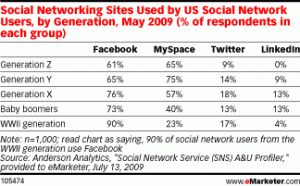Curious about the role social networking sites such as Twitter, Facebook and LinkedIn can play in your Boomer marketing programs? When deciding where to budget your dollars and effort to reach mature consumers, consider the research/statistics. Also, consider the similarities between the offline and online behavior of Baby Boomers and beyond.
“Businesses and mature consumers often approach challenges and decision-making in a similar fashion – cautiously,” we wrote in our summer newsletter. As Creating Results works with clients on comprehensive internet marketing strategies, we recommend acting like the Boomers and Silent Generation members we target: go slowly and be choosy.
Over the next few posts, we’ll be sharing stats on how Facebook, LinkedIn, Twitter and/or niche sites are used by mature (40+) consumers, along with some generational marketing insights to help your organization reach its goals.
PART 1: SOCIAL NETWORKING USE BY GENERATION
eMarketer statistics identify which social networking sites are used by Baby Boomers, WWII, and Generations X, Y and Z:
(Where are the Silents? Anderson Analytics either lumped the roughly 59 million people born between 1925 and 1942 in with the WWII generation or this cohort is very, very quiet indeed.)
The reasons for joining a social network are quite similar across the generations, per eMarketer:
“Sizable percentages of every age group wanted to keep in touch with friends, have fun or stay in contact with family, or had been invited by someone they knew. The youngest users were most likely to be interested in fun and friends, while family contact appealed more to older social networkers.”
Gen X and Boomers were most likely to use social media for job searching, keeping in touch with their business networks or trying to develop/sell business. (No surprise to our team. That’s in keeping with their lifestage.) True “silver surfers” of the WWII generation were all about family ties, per eMarketer data.
At Creating Results, our theory is that how seniors buy into social media can be related to how they buy in general:
- they find out everything they can about this new lifestyle option, through research, demos and trials (David Wolfe’s Ageless Marketing includes research on the effectiveness of new product and new brand trials with 50+ers)
- they trust in referrals from friends – 60% of WWI respondents joined a social network because of an invitation from someone they knew
- most will wait a little while to be sure it’s not a fad or a bad value
- they learn the rules of the game, try to understand how the group will function (remember, Boomers especially have been part of large groups from the moment they hit the playground or school)
- they make sure it’s relevant to them
- THEN, they decide to commit
Should/can marketers connect the dots between the social engagement of older internet users and their “real world” approach to new purchases? Tell us what you think.
In Part II, read about about Twittter use and the older generations. Later this week, we’ll explore the way Baby Boomers and Silent (Ike) Generation members use Facebook, LinkedIn and niche sites such as Eons, Boomj and Teebeedee (RIP).



